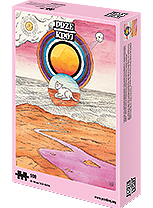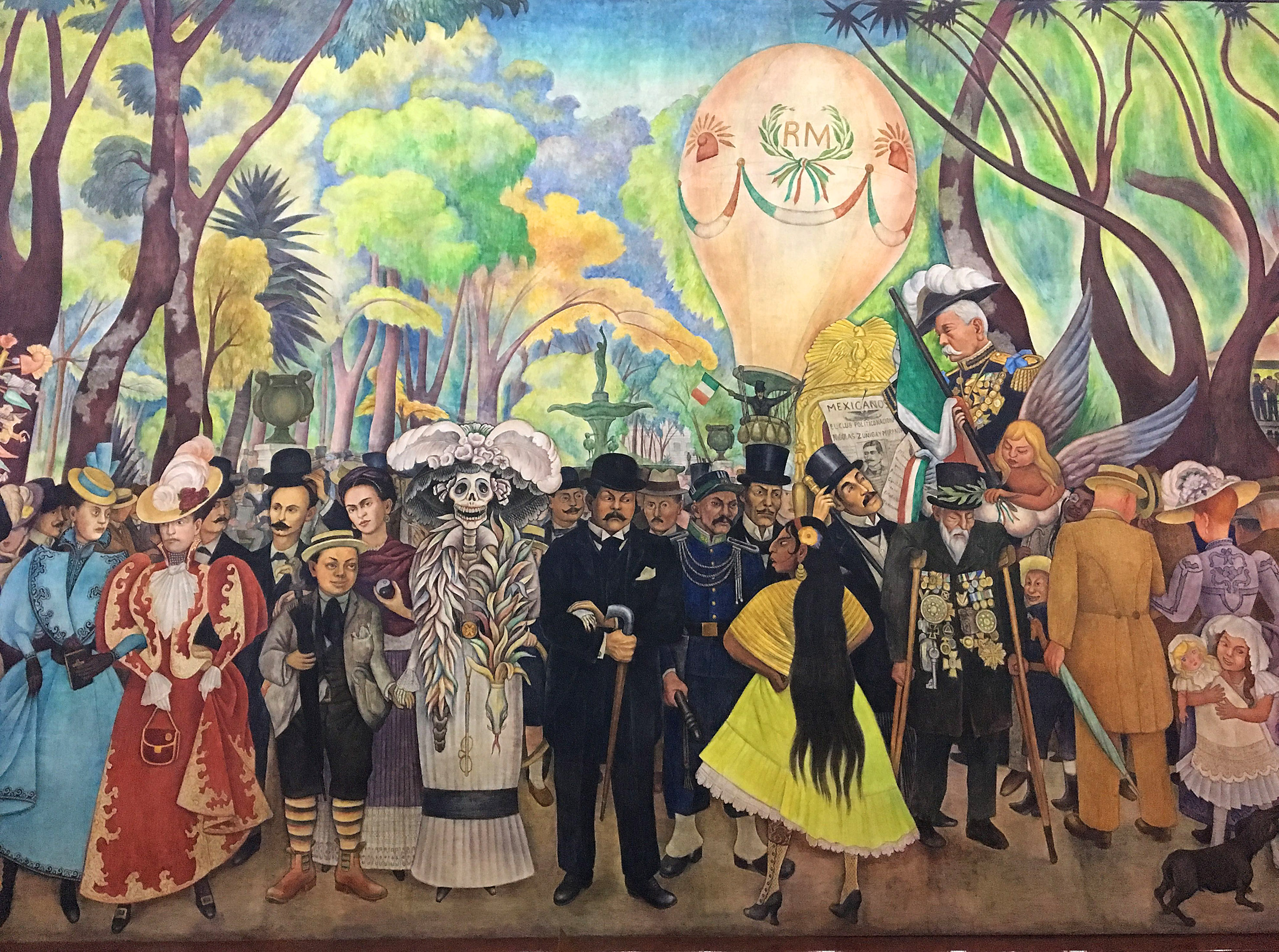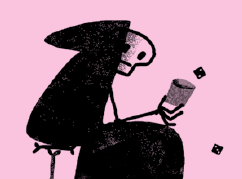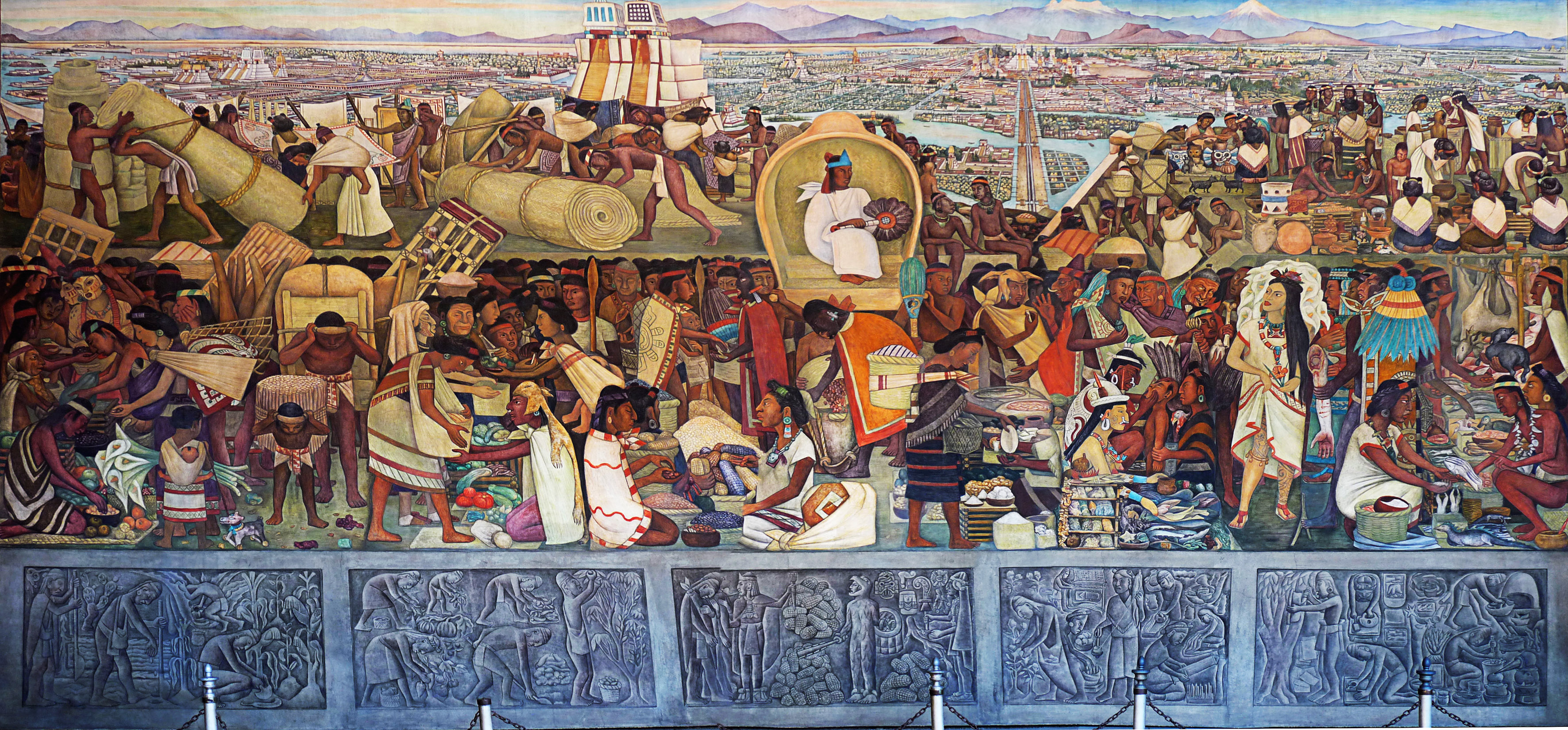
Latinos think that the European concept of death is for wimps. Real death has big cojones; you have to negotiate with it like with the boss of a competing gang. They appease it with gifts, decorate it and worship it – yet they expect reciprocity. New fiestas and cults celebrate death as a part of life and are gaining followers quicker than other modern religions.
1st November, late afternoon. There is a light drizzle at the municipal cemetery in Cusco, Peru. People in festive dress dash through the lanes, while entire families set up camp near the tombs. The dead are usually put to rest here in columbariums, reaching up as high as 10 storeys; you have to use a ladder to get to most of the graves. I walk among the graves and take a closer look at the modest sarcophagi. The graves have glass gates with golden-plated frames. Placed behind these gates are burning candles and vases with flowers, with cut marigolds and ribbons spread about, as well as ceramic figurines of saints accompanied by pictures of the deceased. But there are other gifts, too: chocolate candy bars, the traditional T’anta wawa bread, skulls sculpted from sugar, pocket change and souvenirs. There’s even a bottle of whisky and an ample supply of Coca-Cola in small bottles. A few metres further, in front of yet another tomb, I spot two shot glasses. One is set in the open door, while the other is in the hands of a short, stocky middle-aged man.
“Manuel, Manuel… listen, Manu, you really overdid it that time. You shouldn’t have behaved like that, amigo. I always told you that it would take you down… and now what, huh? Who was right?” the man says, ever more loudly, after which he pours himself some more from a small bottle of cane-based vodka, or aguardiente. He then falls silent for a while, as if he were waiting for an answer. Then he continues: “Yes, yes, go on with your senseless babbling. But who will believe you, Manu? Who will believe you? Enough of that, let’s have a drink. A bit too late to change anything now. A bit too late… to blazes with you! Just one more, we’ll both sleep better, Manu… but especially you.”
As I walk down the same lane two hours later, the stocky man is still engaged in his conversation with Manuel. But the tone is much calmer now: “Manuel, I’ll never forgive you, but rest in peace now. You were a good man, though foolish.… nothing I can do about that. Now go to sleep!”
Not wishing to interrupt the get-together, I take leave of the cemetery.
License for a killer fiesta
Vendors of cuya, or baked guinea pig, set up shop near the gate. In the now dark streets, among the stands and illuminated by microscopic lamps, piles of guinea pig carcasses – with their long sharp teeth and astute though dead eyes – placed in bowls, are a haunting sight. The browned skin of a cavy shines in the pale light of a large light bulb. It’s actually just a regular market offering one of Peru’s most cherished dishes, yet it looks like the scenery from a horror film. But that’s just the first impression. And probably only mine, because the inhabitants of Cusco are having a great time here. They’re seated nearby at large wooden tables. You hear the buzz of conversations and the clink of glass. It’s not only Manuel who is being reminisced now, but entire families and groups of friends as well. The fiesta is on. That’s how they celebrate Día de los Muertos, or the Latino Day of the Dead.
The situation is very much the same at cemeteries in other Latin American cities: Bogota, Quito, Caracas, Santiago, Lima, Asunción, Medellin, San José, Managua or Guadalajara. Perhaps I wouldn’t find any cuya vendors there, but the atmosphere near the graves would be just as loud and joyous. It’s most joyous in Mexico, probably.
The famous Day of the Dead parade in Mexico City, which the world discovered in 2015 thanks to the Bond film Spectre, has a surprisingly short history and came to be for reasons that were purely mercantile. The mayor of the city offered the producers of the film $20 million in exchange for the attractive portrayal of the metropolis on the silver screen. The goal was to revitalize tourism and help Mexico City break the stereotype of a poor, neglected and dangerous capital. The handsome sum convinced the Hollywood bosses, who mandated some significant changes to the script. The scenes from the impressive parade open the 24th episode of the Bond series; the chief black character was not, contrary to initial plans, the mayor of Mexico City, while the corrupted and brutal Mexican police were replaced by troops of intentionally unknown origin. Instead of views of neverending slums, we can admire a panorama with modern skyscrapers. Not to mention that Mexican actor Stephanie Sigman played a role in Spectre.
Bread of the dead and flamingo tamales
The investment in great cinema turned out to be quite adequate. Tourists were more willing to visit Mexico City, while the inhabitants of the metropolis enthusiastically embraced the new, though not exactly secular, tradition. On 1st November 2016, a year after the release of the film, a quarter of a million people took to the streets, and 12 months after that, that number increased to a million. The fiesta was adopted instantly. TV presenters in both state-run and commercial broadcasters promptly started to talk about the “traditional Mexican parade.”
Although it is admittedly young, the fiesta makes a big impression. While it lasts, ruling the streets of Mexico are skeletons, skulls, and grim reapers holding a scythe in their right hands and globes (a symbol of dominion over the world) or scales (a symbol of balance between good and evil) in their left hands. Images of death are available for purchase at stands or straight from the pavement, like drawings on T-shirts or figurines made of sugar. You can also treat yourself to a lethal-themed tattoo. Old women wearing colourful shawls quite spectacularly lament before holy icons placed near graves. Contests for the best decorated grave are organized. Crowds are everywhere. Groups of laughing people eat and drink at long tables. Tequila and Corona beer is poured into glasses. Several varieties of stuffed cornmeal and wheat flatbread fill their plates: tortillas, burritos and enchiladas. Gorditas, fajitas and tacos. And finally tamales, a type of stuffed pocket food wrapped in corn husks. The Aztecs already had this dish – they would stuff it with turkey, frog or flamingo meat, along with eggs, vegetables, honey and fruit. The Maya also enjoyed tamales, but they put iguana meat in theirs. Contemporary Mexicans do not follow these old recipes, save the cornmeal dough. Rather, they stuff their tamales with chicken, pork or beef, along with cheese and beans. During the Mexico City fiesta, you can also enjoy something sweet, such as a pan de muerto – a yeast-based bread of the dead, baked in the shape of a skull or crossbones, and flavoured with orange zest and anise.
Yet the holiday that is meant to be the pride of Mexico – something that is original and unique, something that should distinguish the country throughout the world – oddly resembles the British or American Halloween. Because werewolves, vampires and even American superheroes are also a common sight here. Street stalls are filled with cheap rubbish. In addition to posters associated with death, you have cups shaped like a phallus or female breasts, alongside phallic balloons and vases. The lust for life and the death drive bump into each other on the street. They are closer to each other than you would think, even though the thought would never even occur to the producers and vendors of these gadgets. For a Mexican, death is the essence of life. And life is but a blink of the eye, a moment on the path towards death. So your life has to be fast, powerful and intense; you cannot deny yourself pleasure. The grim reaper can appear at any moment, he can surprise you. You have to seize the day before it turns to night.
Will this year be the same? Will the pandemic grim reaper turn out to be just as terrifying? Will this sinister, yet amusing symbolism take on a new meaning in the COVID era? Will people take to the streets again in such number, disregarding and mocking death lurking around the corner? Or will the horror of death keep them in their homes?
This particular day, Día de los Muertos, is more than just a parade. The Day of the Dead has been celebrated in Latin American countries for a long time, and quite pompously at that. Contrary to the name, it lasts not one day, but several. It starts on 1st November, sometimes even on 31st October, and ends on 2nd November, though it does sometimes extend over the next few days.
The grim reaper transitions
Not all Mexicans remember that the creator of the contemporary face of the local grim reapers was José Guadalupe Posada, a satirist and illustrator who lived at the turn of the 19th and 20th centuries and who was famous for his distinctive strokes. He was the one who adorned the deathly figures in various garments topped with a giant hat, and gave them peculiar spooky smirks. Earlier on, Posada’s drawings mostly featured disliked politicians in the roles of skeletons. With time, death became an independent being, and a new icon was born: La Calavera Garbancera (‘Dapper Skeleton’), a bony depiction of a lady wearing a wide-brimmed hat. It was a satirical representation of the early 20th century Mexican woman. A woman who was ashamed of her roots and tried to carry herself as a European; she would use lots of face powder to look pale and conceal her swarthy complexion, which was characteristic of women from Tijuana all the way to the Yucatan. The Calavera was given a new name, La Catrina (‘Catherine’), many years later by Diego Rivera, the Mexican muralist and partner of painter Frida Kahlo. It was to have a decisively ironic overtone, and be just as pretentious as the style of certain elegant women of the Mexican upper-class. It was Rivera that redid Posada’s skulls to the point that they went from being mere caricatures to national symbols, usually associated with Mexico.
Nobel prize winner for literature Octavio Paz was also one of the promoters of this new lethal aesthetic. In The Labirynth of Solitude, a collection of essays in which the author attempts to capture the character and spirit of Mexicans, he reproaches Europeans, saying that they are even afraid of the word ‘death’, while Mexicans relish it – they love and adore death like a passionate lover. The developing cult of death enjoyed the patronage of the Mexican government; officials viewed the symbolism and glamorous celebrations of the Day of the Dead as an element supporting the integration of a diverse society spread all over a large country and speaking 60 languages. Policymakers concluded that celebration of the relations between the living and the dead could become something that would unite the nation and the numerous cultures coexisting within it (and also that it is quite simply a good export commodity). At the same, it was publicly acknowledged that the Catholic All Saints’ Day and All Souls’ Day in the Mexican tradition have many similarities with the beliefs of the native inhabitants of Mexico: the Aztecs, Maya and Toltecs.
Death has turned into life
So why exactly was the grim reaper supposed to become a national Mexican brand? There are a number of theories out there. One such theory claims that death has been a common experience in the land since the times of the Conquest. The Spanish slaughterers, headed by the dark legend Hernán Cortés – as well as the contagious diseases imported to the continent from Europe (including measles, smallpox and typhoid fever) – exterminated the native inhabitants in a short time and on an unprecedented scale. As scientists from the university in Mexico City (UNAM) estimate, the population of 25 million people living in that area was reduced to only 700,000 in the course of a single century. Death was omnipresent. To cope with their daily fear, people tried to tame the grim reaper, mock and trivialize it. As it became an element of the culture, it also become an element of life.
Yet the celebration of death has a much longer history in Latin American culture than the bloody conquest. Even before the Spaniards came, Aztecs would make human sacrifices for their gods. In their culture, death was not the end, but rather only a mirror reflection of life; a stage in the divine cycle. For many representatives of native ethnic groups, giving one’s life in certain situations would be a noble or even desirable action. As an example, let’s consider the traditional game of pitz, as the Maya called it (the Aztecs referred to it as ullamaliztli; for the Spanish it was pelota). It was a pre-Columbian ballgame in which you could hit the ball with your knees, thighs, hips and buttocks (but not with your feet!), and the goal was to pass the ball through a stone ring, which was usually decorated with a carved likeness of Quetzalcoatl, a feathered serpent that was one of the most important Mesoamerican deities. The game was played near the pyramids of the Maya city Chichen Itza on the Yucatan peninsula, today considered to be one of the so-called New 7 Wonders of the World. Importantly, in pitz competitions, the winner would be granted the privilege of self-sacrifice. Other deities also demanded human sacrifices: Mictēcacihuātl, the goddess of death, decomposition, disease and foul smells, as well as the goddess Cōātlīcue, depicted in a distinctive skirt of snakes, the ruler of life, death and rebirth. For the peoples inhabiting this part of the world before the arrival of Columbus and Cortés, the dead were the intermediaries between the world of the living and the gods.
Overlapping these traditions were the myths and beliefs of the Spanish invaders, such as the their depiction of death as La Parca, the goddess of destiny with roots in Ancient Rome; she decided about life and death as well as the world order, and was the equivalent of one of the Ancient Greek Moirai. La Parca came here from Europe not too long after the plague pandemic of the late Middle Ages. This was when the concept of a danse macabre was born, an allegorical dance of death in which people of all social ranks are equal when they face the White Lady; sooner or later, they will all take part in the horrific procession. That prepared the foundation for the birth of a syncretic religion linking the pre-Columbian world with the world brought over by the conquistadors.
Welcome to Tijuana
In the 1960s, Día de los Muertos officially became a national holiday in Mexico. In spite of this, it was celebrated only in part of the country for many years. People living in the northern states were long oblivious to what all the excitement surrounding the holiday was about.
Up there near the US border, yet another different variant of Mexican Catholicism had developed: the cult of Santa Muerte, or Holy Death. Its origins go far back, at least to the 18th century, but it really evolved only 200 years later. It’s no coincidence that it remains alive in cities with tarnished reputations – like Tijuana and Ciudad Juárez, which rank first and second in Mexico for the number of homicides per 100,000 residents (according to the statistics published by The Citizens’ Council for Public Security and Criminal Justice, 134 people per 100,000 inhabitants were killed in Tijuana, and 104 per 100,000 in Juárez. In absolute figures, this amounts to 2367 homicides over 12 months in Tijuana and 1522 in the smaller Juarez!).
At the beginning of the 21st century, Manu Chao sang: Welcome to Tijuana, tequila, sexo y marijuana […] Bienvenida mi suerte, bienvenida mi muerte (‘Welcome to Tijuana, tequila, sex and marijuana […]. Welcome my happiness, welcome my death’). Not much has changed since then. For years, drug gangs have been involved in an exceptionally brutal war. Drugs, weapons and also people are being smuggled on a massive scale. The value of criminal dealings and the brutality of everyday life is unmatched here, just like the scale of corruption. Nowhere else in the world is the experience of death as common, plain and obvious as it is here. So perhaps we shouldn’t be surprised that it was in these places that the new cult fell on especially fertile ground.
It’s hard not to believe in anything; even paid assassins seem to think that way. They want to be loyal to their patron, Santa Muerte, but they’re not completely selfless in their faith – in exchange for their dedication, they expect specific favours. They have no consideration of Christian ethics here. They believe that the deity can be appeased with a sacrifice, bribed or even blackmailed. Santa Muerte will perhaps grant the wish or not, and material goods are offered: money, sweets, alcohol or… cocaine, which is best added straight to the censer. For followers of the cult, a saint is nothing more than a business partner, just like Jorge or Juan from the neighbouring district. Yet Holy Death holds a special status among her devotees, higher than any regular saint. She does not judge what is right and what is wrong. She is democratic and cannot be deceived, so every single person needs to reckon with her. Yet all the same, you can try to bargain with her. This mindset is deeply rooted in the Latino realm; people quite often talk with figures of Catholic saints, stroke them and cry with them. But they can also yell at them or threaten them if the need arises. The saints play a utilitarian role in the Latino Church. People present them with gifts, but also ask specific favours of them. Saints who meet their commitments can count on privileges. Their figure is moved to a more visible place, near the church altar, for example, and merits more decorative robes. But on the other hand, if a saint becomes tardy, lazy and unwilling to answer to requests or demands, they may end up in the storage room or the sacristy.
The religion of the rejected
Not uncommonly, Latino felons declare themselves to be deeply religious, practising Catholics. Pablo Escobar, the most notorious Columbian criminal of all times, was known for having prayed for the successful transport of drugs to America, for example, or for help in finally eliminating his enemies. To this day, people in Medellin tell the story of how he went to one of the roadside chapels in town to do just that. He met a poor woman there who was praying to a figure of the Virgin Mary for help for her seriously ill son. Pablo walked up and asked her if she could give him some time alone with the Blessed Lady, while placing 300,000 pesos in her hand, a sum she could only dream of. That’s how the legend was created in which Escobar nearly became a holy messenger, the guardian angel of Medellin’s poverty-stricken underclass. That’s where one of his nicknames came from: El Patrón. In the end though, we don’t know whether Mary heard out his request for the safe transport of his goods to Miami.
So for people such as Escobar, the Mexican Santa Muerte was something like the cult of their dreams. Professional sicarios (assassins) prayed to the White Lady to protect them from death during gang shoot-outs, to guide a bullet to their enemy, or for valuable loot during a robbery. But she also attracted other people from the social margins, people who were rejected or despised by society. Thieves, prostitutes, strippers, people from LGBT communities and the homeless. Anybody who didn’t feel respected and valued. Yet nowadays, these groups do not make up the majority of the movement. Currently, the followers of Santa Muerte are mainly workers, peasants or people living in the giant Central and South American slums. The number of devotees of the cult is now estimated to be nearly 20 million. They live not only in Mexico and throughout Latin America, but also in the US, South Africa, Australia, and even Japan.
But for a long time, belief in Santa Muerte was a rather minor phenomenon. The breakthrough came in 2001, when Enriqueta Romero – a resident of Tepito, a rather dodgy district of Mexico City – displayed a large painting with the image of Santa Muerte, or personified death, in the window of her home at 12 Alfareria Street. People started gathering in front of her house shortly thereafter. They brought flowers and jewellery and placed images and figures of the grim reaper decorated with hats and white ribbons. They would light candles for the White Lady and incense for the figures. Interestingly, Holy Death was initially portrayed as a man. Only with time did he become a woman wearing a long robe and holding a scythe and a globe in her hands. To this day, followers meet in front of Enriqueta’s house each first day of the month, while once a year, on 1st November, after sunset, the event takes on greater gravity. The pray the Rosary together, plead together in song and light votive candles. “Santisima Muerte, Blessed Lady, we are with you, we are for you…”, are words that resonate throughout Tepito. For most of the santeros, as her devotees are referred to, these rituals are just enough to show their praise. Yet for the past 30 years, Mexico has been shaken by the increasing reports regarding exceptionally bloody sacrifices made to Santa Muerte.
Femicide
It was the year 1993. In Ciudad Juárez in the state of Chihuahua, on the coast of the Rio Grande river, young women, including girls only a few years old, were disappearing.
For the most part, they were maquiladoras, or underpaid factory workers, who did long shifts of 12 hours and more at factories built near the border by Americans. First, the body of 12-year-old Esperanza Gómez was found in the district of Las Flores. The autopsy revealed that she died of strangulation, and was first beaten, tortured and raped numerous times. Then more bodies of massacred women were found at garbage dumps and in the nearby desert. In 2001, an illegal cemetery was discovered on a cotton field nearby, along with the bodies of eight women – they are now commemorated by eight pink crosses with the names of the girls. According to the official data of Amnesty International, between 1993 and 2005, 370 women were murdered in this manner, although reporters who were investigating the matter believe that the actual figure may be 10 times higher. New facts have been revealed over the past 10 to 15 years. This was by no means the end of the macabre chain. An additional wave of atrocities swept through Juárez in 2010 and 2011, and such crimes still happen today. Who knows how many of these could be linked to the events of the early 1990s? To this day, the police have not unravelled the mystery behind these deaths. Theories included human trafficking and organ trafficking, prostitution, or score-settling between drug cartels. There was a theory surrounding a group of Satanists and psychopathic serial killers. Another theory placed the blame on regular men who would spend time at local bars drinking beer and were dealing with the crisis of their masculinity. The macho culture, which had dominated this part of the world for centuries and which objectified women and nurtured the cult of the lustful strapping male, is not so obvious today as it was only a few decades ago. And that can give rise to frustration.
But then a hypothesis appeared suggesting that the cult of Holy Death could be the reason for such unimaginable brutality. It’s as if they were trying to appease Santa Muerte by doing this. As hard as it is to believe, it seems that at the turn of the 20th and 21st centuries, we were confronting practices perhaps even more cruel than those from pre-Columbian times, when the Aztecs would burn human sacrifices at the stake.
The first suspect was arrested two years after the events. He was Abdul Latif Sharif, an Egyptian-born American, who had earlier worked as a personnel manager at one of the factories that employed many of the murdered victims. Subsequent arrests followed in 1996 – they included members of the Los Rebeldes gang and drivers of buses who would transport workers to the factories. They pleaded guilty, but they did not provide a motive for their crimes. Over time, their confessions were found to be forced by police officers, and the investigation hit a dead end. However, the entire matter resulted in a new law passed in 2011 concerning so-called feminicidio, or femicide (intentional killing of women). People accused of femicide must now expect much harsher sentences (even up to 60 years in jail) compared to other murders.
Yet the bloody march of Santa Muerte doesn’t end there. In 1998, the case of Daniel Arizmendi López, a former policeman known as El Mochaorejas, or the ‘Ear Chopper’, was quite notorious. He would kidnap people for ransom money, and if his demands were not met, he would chop off victims’ ears and send the severed ears to their families. When the police found and arrested López, they discovered that he was a devout follower of Santa Muerte. He even took a figure of the White Lady with him to his cell.
Events that took place in the town of Nacozari de Garcia in the state of Sonora in 2012 were just as notorious. A series of brutal murders all conducted by the same large family was uncovered there. The group was headed by a seemingly level-headed housewife, Señora Silvia Meraz Moreno. Their victims included children and a young woman. They were slaughtered with an axe and their heads were chopped off, all in line with ritual practices. As the investigation revealed, the murdered victims were used to appease the White Lady. At the same time, the Mexican police were destroying temples of the Holy Death located near the US border. But that didn’t help much, as the power of the cult was growing.
The devotees of Santa Muerte refer to themselves as Catholics. Yet the Vatican has a completely different opinion on the matter. In 2013, Cardinal Gianfranco Ravasi, head of the Pontifical Council of Culture, clearly distanced the Church from the cult, describing it as a degeneration of religion and an affirmation of hell. The culture of violence and devastation cannot in any way be reconciled with Christianity, he stressed. Rome forbid practice of the cult.
But that did not convince the followers. Over the past few years, their ranks have increased by millions more devotees. The cult of Santa Muerte is currently considered to be the most rapidly growing religious movement in the world.

A Latino death dictionary
Cōātlīcue – a pre-Columbian goddess who is the ruler of life, death and rebirth.
Día de los Muertos – Latino Day of the Dead. Pompously celebrated on 1st and 2nd November. It makes reference both to the Christian holidays of All Saints’ Day and All Souls’ Day, as well as the Aztec day of the dead, which was celebrated in August.
Feminicidio – femicide (intentional killing of women, because they are female). For the past nine years, crimes against women have been severely punished, with prison sentences of up to 60 years.
La Catrina – the personification of Mexican death. She is usually portrayed as a bony lady wearing a wide-brimmed hat and a smile, holding accessories: a scythe, globe or a scale. Earlier, she was referred to as La Calavera Garbancera. She was brought to life by satirist José Guadalupe Posada, and received her name from painter Diego Rivera.
La Parca – goddess of destiny originating from Ancient Rome who made decisions regarding life and death. The conquistadors of Cortés were the ones who brought her to Mexico and Latin American countries.
Mictēcacihuātl – the Pre-Columbian goddess of death, decomposition, disease and foul smells.
Pan de muerto – bread of the dead, baked in the shape of a skull or crossbones, and flavoured with orange zest and anise.
Pitz – otherwise referred to as ullamaliztli or pelota. A Maya and Aztec game of ball. As the main prize, the winner could die an honourable and prestigious death.
Santa Muerte – the cult of Holy Death, popular especially in Mexico and Central American countries, but also in the southern states of the US. She is often referred to as the White Lady.








